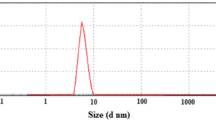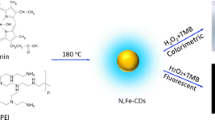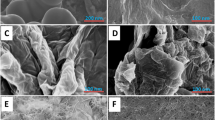Abstract
MXene quantum dots (QDs) are emerging two-dimensional materials from the MXene family that possess unique physicochemical properties and are employed in divergent disciplines, such as energy storage, conversion, catalysis, medicine, and biosensing. In this study, we synthesized MXene QDs using the MAX phase of MXene into its sheets by acidic treatment, followed by doping with ethylenediamine (EDA), and produced nitrogen-doped QDs (NMQDs) via the hydrothermal method. The resulting NMQDs showed excellent fluorescence quenching with a neurotransmitter, i.e., dopamine (DA). These NMQDs showed a strong blue fluorescence with a photoluminescence (PL) emission wavelength maximum of 400 nm under the excitation wavelength maximum of 330 nm. The optical properties of NMQDs were investigated using UV–Vis and PL spectroscopy techniques. The morphological, elemental constitution, and phase composition features were characterized by employing HRTEM, SEM, XPS, XRD, FTIR techniques, etc. The NMQDs delivered high sensitivity towards DA with a limit of detection (LOD) of 18 nM within the linear concentration range between 20 and 100 nM. These results suggest that these NMQDs have the potential to be used as fluorescent sensors for neurotransmitter detection.







Similar content being viewed by others
Data availability
Data available on request.
References
K. Rizwan, A. Rahdar, M. Bilal, H.M. Iqbal, Chemosphere 291, 132820 (2022)
A. Rafieerad, W. Yan, A. Amiri, S. Dhingra, Mater. Des. 196, 109091 (2020)
X. Feng, M. Li, J. Wang, X. Zou, H. Wang, D. Wang, C. Liang, Mater. 15(13), 4543 (2022)
H. Huang, J. Cui, G. Liu, R. Bi, L. Zhang, ACS Nano 13(3), 3448–3456 (2019)
D. Huang, Y. Wu, F. Ai, X. Zhou, G. Zhu, Sens. Actuators B Chem. 342, 130074 (2021)
T.S. Anirudhan, S. Alexander, A. Lilly, Polymers 55(19), 4820–4831 (2014)
H.Y. Lee, S.B. Park, Mol. Biosyst. 7(2), 304–310 (2011)
K. Wang, J. Dong, L. Sun, H. Chen, Y. Wang, C. Wang, L. Dong, RSC Adv. 6(94), 91225–91232 (2016)
C. Zhao, Y. Jiao, J. Hua, J. Yang, Y. Yang, J. Fluoresce 28, 269–276 (2018)
A. Tiwari, S. Walia, S. Sharma, S. Chauhan, M. Kumar, T. Gadly, J.K.J. Randhawa, Mater. Chem. B. 11(5), 1029–1043 (2023)
M.O. Klein, D.S. Battagello, A.R. Cardoso, D.N. Hauser, J.C. Bittencourt, R.G. Correa, Cell. Mol. Neurobiol. 39(1), 31–59 (2019)
H. Juárez Olguín, D. Calderón Guzmán, E. Hernández García, G. Barragán Mejía, Oxid. Med. Cell. Longev. 2016, 1–13 (2016)
R.J. Jakel, W.F. Maragos, Trends Neurosci. 23(6), 239–245 (2000)
R.A. Mitchell, N. Herrmann, K.L. Lanctôt, CNS Neurosci. 17(5), 411–427 (2011)
Kim et al., Nat. Nanotechnol. 13, 812–818 (2018)
K. Qu, J. Wang, J. Ren, X. Qu, Chem. Eur. J. 19, 7243–7249 (2013)
Q. Bai, H. Luo, X. Yi, S. Shi, L. Wang, M. Liu, N. Sui, Microchem. J. 179, 107521 (2022)
J. Gou, L. Zhao, Y. Li, J. Zhang, ACS Appl. Nano Mater. 4(11), 12308–12315 (2021)
Q. Guan, J. Ma, W. Yang, R. Zhang, X. Zhang, X. Dong, Q. Xu, Nanoscale 11(30), 14123–14133 (2019)
R.B. Rakhi, B. Ahmed, M.N. Hedhili, D.H. Anjum, H.N. Alshareef, Chem. Mater. 27(15), 5314–5323 (2015)
Y. Bai, Y. He, Y. Wang, G. Song, Mikrochim. Acta 188, 1–10 (2021)
F. Yan, J. Sun, Y. Zang, Z. Sun, H. Zhang, J. Xu, X. Wang, Dyes Pigm. 195, 109720 (2021)
X. Chen, S. Chen, Q. Ma, Anal. Methods 9(15), 2246–2251 (2017)
H. Shabbir, E. Csapó, M. Wojnicki, Inorganics 11(6), 262 (2023)
J. Manioudakis, F. Victoria, C.A. Thompson, L. Brown, M. Movsum, R. Lucifero, R. Naccache, J. Mater. Chem. C 7(4), 853–862 (2019)
K.G. Nguyen, I.A. Baragau, R. Gromicova, A. Nicolaev, S.A. Thomson, A. Rennie, S. Kellici, Sci. Rep. 12(1), 13806 (2022)
Channer et al., Pharmacol. Rev. 75, 62–158 (2023)
C. Liu, F. Zhang, J. Hu, W. Gao, M. Zhang, Front. Chem. 8, 605028 (2021)
C. Zhao, X. Li, C. Cheng, Y. Yang, Microchem. J. 147, 183–190 (2019)
K. Winbeck, H. Poppert, T. Etgen, B. Conrad, D. Sander, Stroke 33(10), 2459–2464 (2002)
X. Liu, M. Tian, W. Gao, J. Zhao, J. Anal. Methods Chem. 2019, 1–7 (2019)
P. Palladino, F. Torrini, S. Scarano, M. Minunni, J. Pharm. Biomed. Anal. 179, 113016 (2020)
I.L. Medintz, M.H. Stewart, S.A. Trammell, K. Susumu, J.B. Delehanty, B.C. Mei, H. Mattoussi, Nat. Mater. 9(8), 676–684 (2010)
Acknowledgements
This research was support by Basic Science Research Program through National Research Foundation of Korea (NRF) funded by the Ministry of Education (2021R1A6A1A03038996) and by the National Research Foundation of Korea (NRF) grant funded by the Korea government (MSIT) (NRF-2022R1A2C1009968). The authors would like to thank the Smart Materials Research Center for IoT at Gachon University for their technical support with instruments (FT-IR and SEM).
Funding
The work of Jong Sung Kim was funded by National Research Foundation of Korea (NRF) funded by the Ministry of Education (2021R1A6A1A03038996), and National Research Foundation of Korea (NRF) grant funded by the Korea government (NRF-2022R1A2C1009968).
Author information
Authors and Affiliations
Corresponding author
Ethics declarations
Conflict of Interest
The authors declare that they have no known competing financial interests or personal relationships that could have appeared to influence the work reported in this paper.
Additional information
Publisher's Note
Springer Nature remains neutral with regard to jurisdictional claims in published maps and institutional affiliations.
Supplementary Information
Below is the link to the electronic supplementary material.
Rights and permissions
Springer Nature or its licensor (e.g. a society or other partner) holds exclusive rights to this article under a publishing agreement with the author(s) or other rightsholder(s); author self-archiving of the accepted manuscript version of this article is solely governed by the terms of such publishing agreement and applicable law.
About this article
Cite this article
Rajapriya, G., Sangubotla, R. & Kim, J. Synthesis of a Fluorescent Sensor by Exploiting Nitrogen-Doped MXene Quantum Dots for the Detection of Dopamine. Korean J. Chem. Eng. (2024). https://doi.org/10.1007/s11814-024-00144-y
Received:
Revised:
Accepted:
Published:
DOI: https://doi.org/10.1007/s11814-024-00144-y




